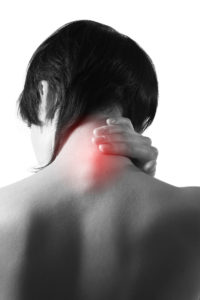 Your neck, also called the cervical spine, begins at the base of the skull and contains seven small vertebrae. Incredibly, the cervical spine supports the full weight of your head, which is on average about 12 pounds. While the cervical spine can move your head in nearly every direction, this flexibility makes the neck very susceptible to pain and injury.
Your neck, also called the cervical spine, begins at the base of the skull and contains seven small vertebrae. Incredibly, the cervical spine supports the full weight of your head, which is on average about 12 pounds. While the cervical spine can move your head in nearly every direction, this flexibility makes the neck very susceptible to pain and injury.
The neck’s susceptibility to injury is due in part to biomechanics. Activities and events that affect cervical biomechanics include extended sitting, repetitive movement, accidents, falls and blows to the body or head, normal aging, and everyday wear and tear. Neck pain can be very bothersome, and it can have a variety of causes.
Just like lower back, there are many causes of neck pain. Following an examination, Dr. Ken Andersen will determine the best course of action that may include specific spinal adjustments, physiotherapy, and cervical stretching/strengthening exercises. Dr. Ken Andersen, our Sandy Chiropractor has been successfully treating neck pain since 2001.
Come see Dr. Ken Andersen for all your chiropractic needs, call to schedule and appointment at 801-963-8750 or feel free to contact us online.
Neck Pain Treatment Resources:
Spinal Manipulation, Medication, or Home Exercise With Advice
for Acute and Subacute Neck Pain: A Randomized Trial - Annals of Internal Medicine 2012 (Jan 3); 156 (1 Pt 1): 1–10
Predictors of Outcome in Neck Pain Patients Undergoing Chiropractic Care: Comparison of Acute and Chronic Patients - Chiropractic & Manual Therapies 2012 (Aug 24); 20 (1): 27
Chiropractic Management for Veterans with Neck Pain:
A Retrospective Study of Clinical Outcomes - J Manipulative Physiol Ther. 2011 (Oct); 34 (8): 533–538
The Benefits Outweigh the Risks for Patients Undergoing Chiropractic
Care for Neck Pain: A Prospective, Multicenter, Cohort Study - J Manipulative Physiol Ther 2007 (Jul); 30 (6): 408–418
Efficacy of Spinal Manipulation and Mobilization for Low Back Pain
and Neck Pain: A Systematic Review and Best Evidence Synthesis- Spine Journal (of the North American Spine Society) 2004 (May); 4 (3): 335–356
